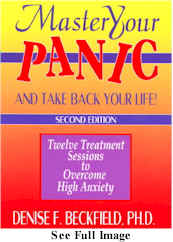|
Master Your Panic
and Take Back Your Life |
Table Of Contents
 Learning Objectives
Learning Objectives
After completion of the course you’ll be able to:
- Describe typical features of panic disorder and list 13 diagnostic symptoms of a panic attack.
- Complete an exercise with a client to identify sources of client’s panic disorder.
- Describe personality traits of panic sufferers.
- Explain how certain kinds of events are particularly likely to bring on panic attacks in
individuals who are predisposed.
- Discuss the correlation between thoughts and feelings and the timing of panic attacks.
- Teach a client a simple, effective breathing technique to reduce the physical symptoms of
anxiety.
- List physical changes produced by over breathing.
- Explain four ways in which controlled breathing can help you eliminate panic.
- Demonstrate controlled breathing technique.
- Distinguish between a panic attack and an emergency response to danger.
- Describe the two stages of a panic attack and explain how to halt a panic attack.
- Teach a client how to “catch” a panic attack before it catches him or her.
- List three reasons to identify triggers of panic attack.
- Identify four common triggers for panic sensations.
- Teach a client to challenge anxiety-producing self-talk and replace it with more realistic,
more helpful self-talk for overcoming panic.
- Ask 12 questions to challenge catastrophic self-statements that lead to full-blown panic
attack.
- Explain to a client the concept of exposure hierarchy and help the client implement it
step-by-step.
- Describe how exposure method can be used to control internal sensations.
- Explain why medications for panic may be needed in certain situations.
- List three classes of antidepressant medications and various specific drugs popularly used for
panic disorder.
- Describe the benefits and drawbacks of benzodiazepines in combating panic.
- Describe eight strategies that will help a client to prevent a return of panic symptoms.
Course Evaluation
To assess the effectiveness of the course material, we ask that you evaluate your
achievement of each learning objective on a scale of A to D (A=excellent, B=good, C=fair,
D=unsatisfactory). Please indicate your responses next to each learning objective and return it to
us with your completed exam.
Table Of Contents
"First
Aids" for Panic
Introduction: What's In Store - And Is It For Me?
Session 1: What Is Panic?
Session 2: The Roots of Panic: Why Me?
Session 3: Panic and Personality
Session 4: The Timing of Panic: Why Now?
Session 5: Take a Deep Breath...
Session 6: When Panic Hits
Session 7: The Triggers of Panic
Session 8: Challenging Catastrophic Beliefs
Session 9: Taking Back Your Life
Session 10: Internal Affairs
Session 11: The Question of Medications
Session 12: Where Have You Been? Where Are You Going?
Special Section: Everyday Anxieties
Appendix I: Relaxation Techniques
Appendix II: Troubleshooting: Controlled Breathing
Appendix III: Troubleshooting: Exposure
Appendix IV: Troubleshooting: Unsatisfying Outcomes
Appendix V: Reference Notes
Appendix VI: Record - Keeping Forms
Index
Comments:
"Informative learning.
Presents the latest issues and addresses pain from the holistic approach." -
O.C., RN, TX
 Back To The Top
Back To The Top
Go Back
|
© 2007 Homestead
Schools, Inc. - Webmaster : Shawn J. Cassick |
 Learning Objectives
Learning Objectives